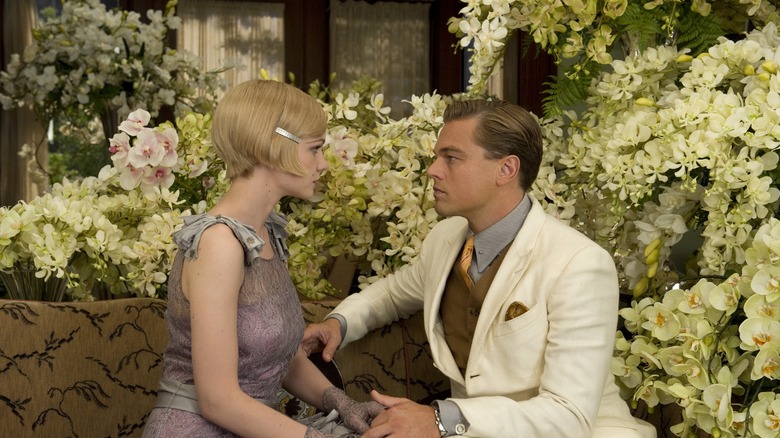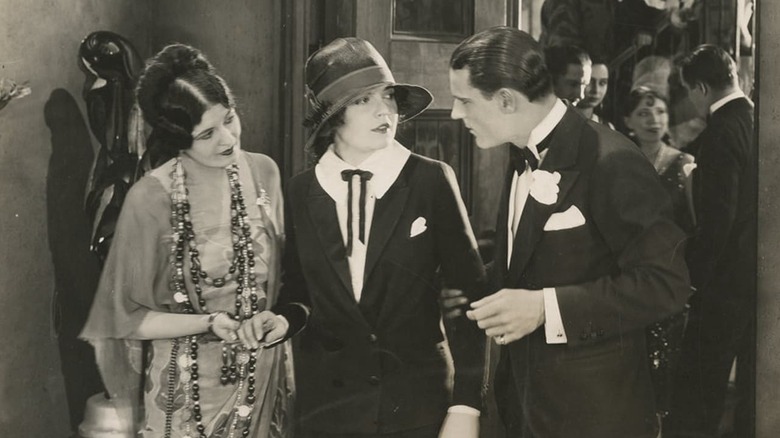The talk about what constitutes The Nice American Novel is endless, but F. Scott Fitzgerald’s “The Nice Gatsby” all the time finds its manner into this dialog. It is likely to be tempting to easily cut back the creator’s work to an everlasting portrayal of the Roaring Twenties, however Fitzgerald’s e book additionally cuts by means of the illusions whereas sustaining the enthralling thriller surrounding its titular determine. As soon as the mist dissipates, and each Jay Gatsby and his (solely) good friend Nick Carraway are laid naked for who they’re, what stays is a profound sense of vacancy. Do not get me fallacious: “The Nice Gatsby” is a narrative about the inherent hollowness of spectacle, obscene wealth, and relationships of comfort which have the phantasm of depth. Nonetheless, as soon as we confront the uncommon flashes of shifting sincerity in a story so luridly tragic, the empty lure of the inexperienced gentle on the coronary heart of the novel takes on a very haunting sheen.
Absolutely, such a posh, beloved e book has birthed no less than one display adaptation that comes near capturing its elusive essence … proper? Properly, there aren’t any simple solutions, as some cinematic renditions of “The Nice Gatsby” are certainly worthwhile, regardless of their intrinsic flaws. The most recent (and popular) rendition is Baz Luhrmann’s 2013 version starring Leonardo DiCaprio and Tobey Maguire, which has been criticized for dropping itself within the loud hedonism it’s meant to critique, leaving little house for subtlety. I’d argue that Luhrmann carves out ample space for tense, interior moments, particularly whereas exploring the crumbling mythos encircling Gatsby when he is on the verge of dropping every thing. That stated, the movie would not come near doing justice to its supply materials’s complexities, though it by no means pretends to be one thing it’s not.
If we’re to contemplate Rotten Tomatoes because the metric for figuring out the perfect Gatsby adaptation, then 1926’s “The Great Gatsby” is the winner with its 52% score. Yep, that is the very best combination thus far, and each different direct movie adaptation of the novel — versus loosely-inspired ones — has a “rotten” rating on the platform.
How the 1926 Gatsby adaptation is completely different from the remaining
Earlier than we discuss in regards to the 1926 model, allow us to contact upon one other well-remembered “Great Gatsby” adaptation that was released in 1974, with Robert Redford and Mia Farrow taking up the respective roles of Gatsby and Daisy Buchanan. Director Jack Clayton remained devoted to Fitzgerald’s novel (too devoted to the purpose of drabness), bringing memorable excerpts to life with dedicated performances and vivid set dressing. However regardless of these honest efforts, which included a reliable screenplay by Francis Ford Coppola, the movie fails to seize the hypnotic pull of the themes that also spellbind us, leading to an adaptation that by no means dares to search out its personal footing.
Circling again to the 1926 silent drama by Herbert Brenon (“Peter Pan,” “Neptune’s Daughter”), we should always actually acknowledge simply how a lot it diverges from the unique novel. Regardless of being a direct (and seemingly the primary) film adaptation of the novel, it adjustments key elements in regards to the central characters, together with Daisy’s (Lois Wilson) motivations for rejecting Gatsby (Warner Baxter) and the underlying circumstances surrounding the deadly automobile accident towards the top. The fundamental beats of the story are retained although, with a younger Nick Carraway (Neil Hamilton) progressively seeing Gatsby for what he really is whereas additionally coming to acknowledge the callous cruelty and hypocrisy of the Buchanans. In a fairly odd departure from the novel, nonetheless, the movie ends with an idyllic shot of the Buchanans and their new child, with no lingering hints of the tragedy they immediately contributed to (or the person on the heart of it).
The rationale why Brenon’s movie isn’t featured in conversations about Gatsby is as a result of it’s now thought-about misplaced media, with solely the trailer and some brief clips from the movie being obtainable for viewing. It is also price noting that Fitzgerald abhorred this adaptation, describing it as “rotten and terrible and horrible,” though he did not elaborate why. In case your seek for a serviceable “Nice Gatsby” film adaptation stays unsatisfactory, you’ll be able to all the time give Robert Markowitz’s 2000 model a good likelihood. It may not be a lot, however the movie stars Paul Rudd in a formidable flip as Carraway, which is, maybe, its solely redeemable high quality.
The talk about what constitutes The Nice American Novel is endless, but F. Scott Fitzgerald’s “The Nice Gatsby” all the time finds its manner into this dialog. It is likely to be tempting to easily cut back the creator’s work to an everlasting portrayal of the Roaring Twenties, however Fitzgerald’s e book additionally cuts by means of the illusions whereas sustaining the enthralling thriller surrounding its titular determine. As soon as the mist dissipates, and each Jay Gatsby and his (solely) good friend Nick Carraway are laid naked for who they’re, what stays is a profound sense of vacancy. Do not get me fallacious: “The Nice Gatsby” is a narrative about the inherent hollowness of spectacle, obscene wealth, and relationships of comfort which have the phantasm of depth. Nonetheless, as soon as we confront the uncommon flashes of shifting sincerity in a story so luridly tragic, the empty lure of the inexperienced gentle on the coronary heart of the novel takes on a very haunting sheen.
Absolutely, such a posh, beloved e book has birthed no less than one display adaptation that comes near capturing its elusive essence … proper? Properly, there aren’t any simple solutions, as some cinematic renditions of “The Nice Gatsby” are certainly worthwhile, regardless of their intrinsic flaws. The most recent (and popular) rendition is Baz Luhrmann’s 2013 version starring Leonardo DiCaprio and Tobey Maguire, which has been criticized for dropping itself within the loud hedonism it’s meant to critique, leaving little house for subtlety. I’d argue that Luhrmann carves out ample space for tense, interior moments, particularly whereas exploring the crumbling mythos encircling Gatsby when he is on the verge of dropping every thing. That stated, the movie would not come near doing justice to its supply materials’s complexities, though it by no means pretends to be one thing it’s not.
If we’re to contemplate Rotten Tomatoes because the metric for figuring out the perfect Gatsby adaptation, then 1926’s “The Great Gatsby” is the winner with its 52% score. Yep, that is the very best combination thus far, and each different direct movie adaptation of the novel — versus loosely-inspired ones — has a “rotten” rating on the platform.
How the 1926 Gatsby adaptation is completely different from the remaining
Earlier than we discuss in regards to the 1926 model, allow us to contact upon one other well-remembered “Great Gatsby” adaptation that was released in 1974, with Robert Redford and Mia Farrow taking up the respective roles of Gatsby and Daisy Buchanan. Director Jack Clayton remained devoted to Fitzgerald’s novel (too devoted to the purpose of drabness), bringing memorable excerpts to life with dedicated performances and vivid set dressing. However regardless of these honest efforts, which included a reliable screenplay by Francis Ford Coppola, the movie fails to seize the hypnotic pull of the themes that also spellbind us, leading to an adaptation that by no means dares to search out its personal footing.
Circling again to the 1926 silent drama by Herbert Brenon (“Peter Pan,” “Neptune’s Daughter”), we should always actually acknowledge simply how a lot it diverges from the unique novel. Regardless of being a direct (and seemingly the primary) film adaptation of the novel, it adjustments key elements in regards to the central characters, together with Daisy’s (Lois Wilson) motivations for rejecting Gatsby (Warner Baxter) and the underlying circumstances surrounding the deadly automobile accident towards the top. The fundamental beats of the story are retained although, with a younger Nick Carraway (Neil Hamilton) progressively seeing Gatsby for what he really is whereas additionally coming to acknowledge the callous cruelty and hypocrisy of the Buchanans. In a fairly odd departure from the novel, nonetheless, the movie ends with an idyllic shot of the Buchanans and their new child, with no lingering hints of the tragedy they immediately contributed to (or the person on the heart of it).
The rationale why Brenon’s movie isn’t featured in conversations about Gatsby is as a result of it’s now thought-about misplaced media, with solely the trailer and some brief clips from the movie being obtainable for viewing. It is also price noting that Fitzgerald abhorred this adaptation, describing it as “rotten and terrible and horrible,” though he did not elaborate why. In case your seek for a serviceable “Nice Gatsby” film adaptation stays unsatisfactory, you’ll be able to all the time give Robert Markowitz’s 2000 model a good likelihood. It may not be a lot, however the movie stars Paul Rudd in a formidable flip as Carraway, which is, maybe, its solely redeemable high quality.




















